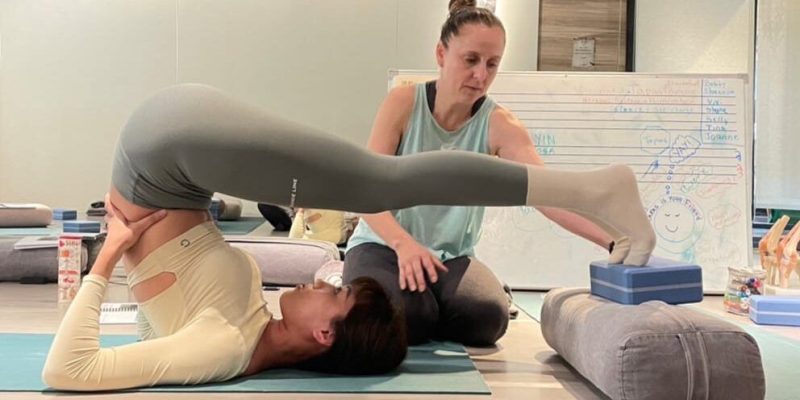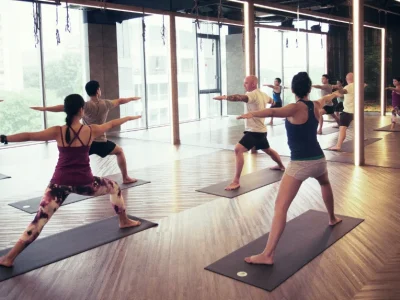
The modern workplace has transformed dramatically, yet one thing remains constant — long hours spent at a desk. Whether in a corporate office or working from home, extended periods of sitting can wreak havoc on your posture, flexibility, circulation, and mental well-being. Over time, this sedentary routine leads to tight hips, rounded shoulders, lower back pain, and chronic fatigue. For those caught in this cycle, yin yoga offers a powerful, low-effort way to reverse the damage.
Unlike fast-paced yoga styles or gym routines, yin yoga is slow, still, and profoundly restorative. It targets deep connective tissues, fascia, and joints — areas most affected by prolonged sitting. For office workers, this practice becomes an essential tool for physical recovery, mental clarity, and stress management.
This article explores how yin yoga can restore balance to the desk-bound body and mind, providing practical guidance for daily relief and long-term posture correction.
The Hidden Impact of Desk Jobs on the Body
Many people assume a desk job is physically safe. After all, there’s no heavy lifting or strenuous labour. But sitting for eight or more hours a day is one of the most damaging habits to overall health. Here’s how:
-
Hips tighten, particularly the hip flexors, due to constant shortening
-
Spine rounds, leading to poor posture and back pain
-
Neck and shoulders stiffen from leaning towards screens
-
Circulation slows, causing leg swelling and fatigue
-
Muscles weaken, especially the core and glutes
-
Fascia binds, losing elasticity from disuse
These changes don’t just affect how you feel physically. They influence your mood, focus, and energy levels, often leading to burnout or lack of motivation.
Why Yin Yoga Is Perfect for the Desk-Bound
1. Targets Deep Connective Tissue
Office work doesn’t just tighten muscles, it affects fascia — the fibrous network surrounding muscles and joints. Yin yoga holds each pose for 3 to 7 minutes, which gently stresses these deeper tissues to promote release, hydration, and elasticity.
This makes it ideal for undoing long-term postural imbalances and stiffness that regular stretching can’t fully address.
2. Requires Minimal Physical Effort
After a long workday, the last thing most people want is an intense workout. Yin yoga doesn’t demand energy or strength. It invites you to rest, breathe, and simply let gravity do the work.
This makes it a sustainable practice for busy professionals, regardless of fitness level or flexibility.
3. Improves Focus and Mental Clarity
Desk work often leads to mental fatigue, information overload, and stress. Yin yoga provides a built-in mindfulness practice. As you settle into each pose, your breath slows, your awareness sharpens, and your mind begins to declutter.
This mental reset is invaluable for productivity and emotional regulation — helping you return to your tasks with renewed clarity.
4. Supports Better Posture and Spinal Health
Spending hours hunched over keyboards and phones leads to spinal misalignment. Yin yoga introduces spinal decompression and gentle backbends to counteract this rounding.
With regular practice, you’ll find your posture improving naturally, without having to “force” yourself to sit upright.
Best Yin Yoga Poses for Office Workers
Here are some key poses that specifically address the tightness and imbalances caused by desk jobs. Each pose can be done at home with minimal space and simple props like a cushion, blanket, or bolster.
-
Dragon Pose (Lunge Variation)
Opens tight hip flexors and groin. Great for releasing tension from sitting. -
Supported Fish Pose
A gentle chest opener that reverses slouching and opens the front body. -
Sphinx Pose
Encourages a healthy lumbar curve and strengthens the lower back. Perfect for offsetting spinal flattening from sitting. -
Shoelace Pose
Targets the outer hips and glutes, which become tight and underused from prolonged sitting. -
Legs-Up-the-Wall
Reduces lower-body swelling, improves circulation, and calms the nervous system — ideal for post-work unwinding. -
Reclining Twist
Realigns the spine, massages the internal organs, and relieves lower back tension.
Hold each pose for 3–5 minutes. Breathe deeply, and avoid using muscular effort. Use cushions and props for comfort so the body can fully relax.
When and How to Practise Yin Yoga During the Work Week
1. After Work Wind-Down
Practising yin yoga at the end of your workday helps your body and mind shift gears. Just 20–30 minutes can dramatically reduce stiffness and stress before dinner or sleep.
2. Lunchtime Reset
If you work from home or have a quiet space in the office, a brief midday yin session (15–20 minutes) can prevent tension from accumulating. This is especially helpful on high-stress days.
3. Weekly Deep Recovery
Consider dedicating one or two evenings per week for a longer yin session (45–60 minutes) to fully unwind your body and nervous system.
If you’re looking for structured guidance, consider exploring classes with Yoga Edition, which offers calm, restorative sessions ideal for working professionals.
Beyond the Body: Mental and Emotional Benefits
Office work isn’t just physically draining — it takes a mental toll. The pressure to perform, constant deadlines, and screen fatigue often lead to anxiety, irritability, or low motivation.
Yin yoga helps regulate these emotional states. Its meditative nature calms the mind, encourages introspection, and creates space to process stress without reactivity.
With time, practitioners often report:
-
Greater emotional stability
-
Reduced workplace anxiety
-
Improved problem-solving and creativity
-
Enhanced resilience under pressure
A Real-Life Perspective from Office Workers
-
“I used to get tension headaches by 4pm every day. After starting yin yoga three evenings a week, my neck pain is almost gone and I sleep better too.” – Felicia, 34
-
“Working from home blurred the lines between work and rest. Yin yoga became my transition. It’s like clocking out for the mind and body.” – Alvin, 39
-
“Yin taught me to listen to my body. I didn’t realise how much stress I held in my back and hips until I started slowing down and noticing it.” – Melissa, 29
These stories are echoed by countless others who’ve integrated yin yoga into their daily routine, not as exercise, but as essential maintenance.
FAQ
Q. How often should I practise yin yoga if I work a desk job?
A. Two to three times per week is ideal. If you sit for long hours daily, even a short 15-minute yin session after work can bring noticeable benefits.
Q. Do I need to be flexible to start yin yoga?
A. Not at all. Yin yoga meets you where you are. With the help of props and supportive setups, anyone can practise safely and comfortably.
Q. Can I do yin yoga at the office?
A. While full sessions might be difficult, some seated or floor-based poses like Seated Forward Fold or Neck Rolls can be done during breaks. You can also practise Legs-Up-the-Wall by resting against a couch or sturdy wall.
Q. Is yin yoga better than stretching after work?
A. Yin yoga goes beyond stretching. It targets fascia, joints, and the nervous system, offering deeper and longer-lasting release compared to brief muscular stretches.
Q. How long before I see improvements in posture or pain?
A. Many practitioners notice changes within 2–4 weeks of consistent practice. Pain reduction, better posture, and emotional calm tend to appear gradually with regular sessions.











